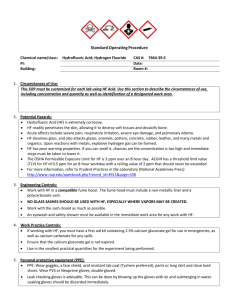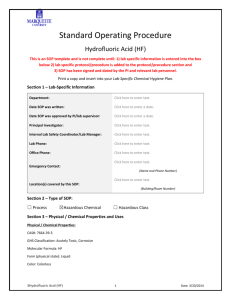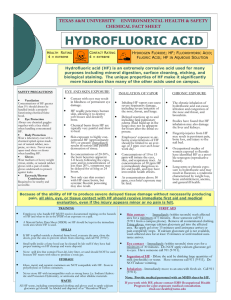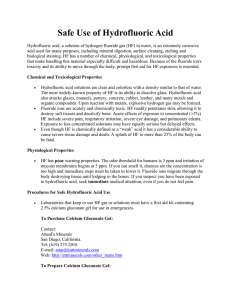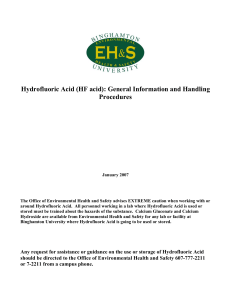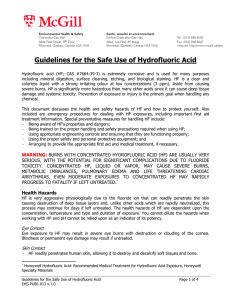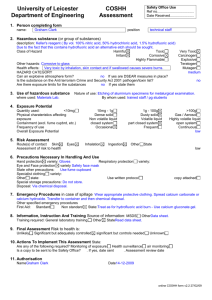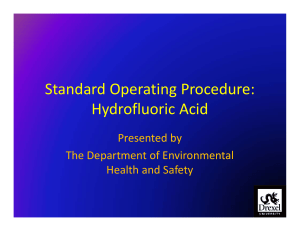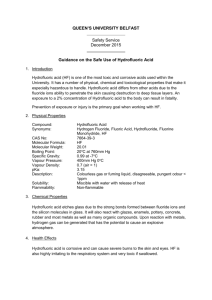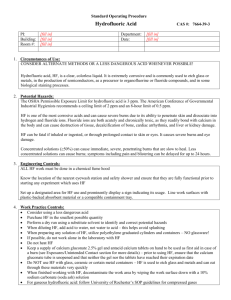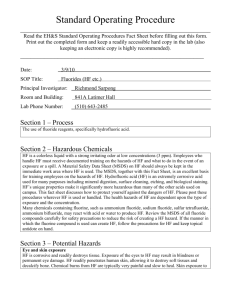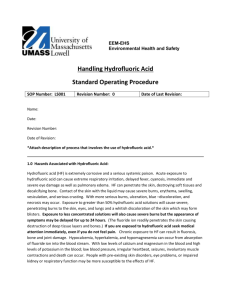gel acids
advertisement
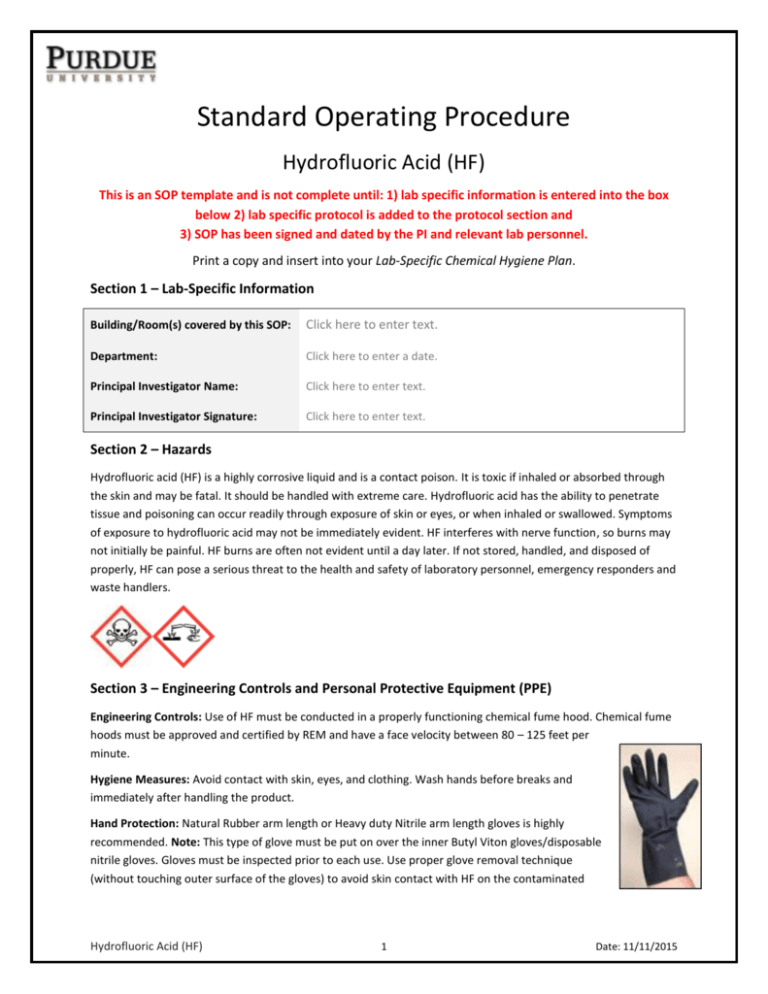
Standard Operating Procedure Hydrofluoric Acid (HF) This is an SOP template and is not complete until: 1) lab specific information is entered into the box below 2) lab specific protocol is added to the protocol section and 3) SOP has been signed and dated by the PI and relevant lab personnel. Print a copy and insert into your Lab-Specific Chemical Hygiene Plan. Section 1 – Lab-Specific Information Building/Room(s) covered by this SOP: Click here to enter text. Department: Click here to enter a date. Principal Investigator Name: Click here to enter text. Principal Investigator Signature: Click here to enter text. Section 2 – Hazards Hydrofluoric acid (HF) is a highly corrosive liquid and is a contact poison. It is toxic if inhaled or absorbed through the skin and may be fatal. It should be handled with extreme care. Hydrofluoric acid has the ability to penetrate tissue and poisoning can occur readily through exposure of skin or eyes, or when inhaled or swallowed. Symptoms of exposure to hydrofluoric acid may not be immediately evident. HF interferes with nerve function, so burns may not initially be painful. HF burns are often not evident until a day later. If not stored, handled, and disposed of properly, HF can pose a serious threat to the health and safety of laboratory personnel, emergency responders and waste handlers. Section 3 – Engineering Controls and Personal Protective Equipment (PPE) Engineering Controls: Use of HF must be conducted in a properly functioning chemical fume hood. Chemical fume hoods must be approved and certified by REM and have a face velocity between 80 – 125 feet per minute. Hygiene Measures: Avoid contact with skin, eyes, and clothing. Wash hands before breaks and immediately after handling the product. Hand Protection: Natural Rubber arm length or Heavy duty Nitrile arm length gloves is highly recommended. Note: This type of glove must be put on over the inner Butyl Viton gloves/disposable nitrile gloves. Gloves must be inspected prior to each use. Use proper glove removal technique (without touching outer surface of the gloves) to avoid skin contact with HF on the contaminated Hydrofluoric Acid (HF) 1 Date: 11/11/2015 gloves. Dispose of inner nitrile gloves after use as hazardous waste. Inner Butyl Viton gloves can be reused carefully (i.e., without touching the outer surface of the gloves). Wash hands thoroughly with warm water and soap. NOTE: Consult with your preferred glove manufacturer to ensure that the gloves you plan on using are compatible with HF. Eye Protection: ANSI approved properly fitting safety glasses or chemical splash goggles are required. A face shield may also be appropriate depending on the specific application. Skin and Body Protection: A lab coat and rubber apron must be worn at a minimum. The lab coat must be appropriately sized for the individual and buttoned to their full length. Personnel must also wear full length pants, or equivalent, and close-toed shoes. Full length pants and close-toed shoes must be worn at all times by all individuals that are occupying the laboratory area. The area of skin between the shoe and ankle must not be exposed. Additional protection may be required depending on the application and volume of HF being used. Respiratory Protection: HF should never be used outside of a chemical fume hood or glove box; therefore respiratory protection should not be required. Section 4 – First Aid Procedures All labs that store and use HF must have a HF First Aid Kit with the following first aid supplies: Calcium Gluconate 2.5% Gel Milk of Magnesia Eyewash 1% Calcium Gluconate Solution NOTE: All three of these products expire and must be maintained (annual purchases must be made to keep the kit current) If inhaled: Dial 911. Move to fresh air. If the person is not breathing, give artificial respiration. Avoid mouth to mouth contact. In case of skin contact: Dial 911. Immediately (within seconds) flush affected area for at least 5 minutes. Remove all contaminated clothing. Wearing compatible gloves, massage calcium gluconate 2.5% gel into the affected area. Re-apply every 15 minutes until medical help arrives. NOTE: HF exposure is often treated with calcium gluconate, a source of Ca 2+ that sequesters the fluoride ions. HF chemical burns can be treated with water and 2.5% calcium gluconate gel, or special rinsing solutions. However, because it is absorbed, medical treatment is necessary. Intra-arterial infusions of calcium chloride have also shown great effectiveness in treating HF burns. In some cases, amputation has been required. In case of eye contact: Dial 911. Flush eyes with water for 5 minutes. Then, use 1% Calcium Gluconate emergency eyewash solution. NOTE: Do not open the emergency eyewash solution seal unless it needs to be used. Use the entire 120 ml content during an emergency (eye exposure). Emergency eyewash solution is for single use only. Hydrofluoric Acid (HF) 2 Date: 11/11/2015 If swallowed: Dial 911. Do not induce vomiting. Drink large quantities of water then drink 12 ounces of milk of magnesia. Never give anything by mouth to unconscious person. Section 5 – Special Handling and Storage Requirements Ensure that you have all the PPE required for handling HF. HF must always be stored in plastic (Nalgene / polypropylene) containers. Do not store HF in glass bottles/containers. Store in corrosive/acid/lab storage cabinet within a secondary containment (Nalgene/ polypropylene tray or tub). Do not store in the top most shelf of the storage cabinet. In general, do not store chemicals at or above eye level. Ensure the container is tightly closed at all times. A current copy of the HF SDS must be made available to all personnel working in the laboratory at all times. Do not store with oxides, organic chemicals, bases or metals. Carefully carry the stock bottle in a rubber maid bottle carrier/nalgene secondary container to the wet bench/chemical fume hood and pour out desired amount into a smaller container. Place stock bottle back in corrosive chemical storage cabinet with cap tightly closed. Lab buddy system is highly recommended when handling HF. Lab emergency contact information must be readily available. The lab personnel must have easy access to a telephone (landline or cell phone). Section 6 – Spill and Accident Procedures Immediately evacuate area and ensure others are aware of the spill. If there is an imminent threat building occupants, pull the nearest fire alarm station to evacuate the building and dial 911. If personnel have become exposed and need medical assistance, dial 911. Section 7 – Waste Disposal Procedures Store hazardous waste in closed containers that are properly labeled, and in a designated area (flammable cabinet is recommended) away from incompatible chemicals such as aqueous solutions. Complete a Chemical Waste Pickup Request Form to arrange for disposal by REM; detailed instructions are provided at the following link: http://www.purdue.edu/ehps/rem/hmm/chemwaste.htm. Section 8 – Protocol (Add lab specific Protocol here) Click here to enter text. NOTE: Any deviation from this SOP requires approval from Principal Investigator. Section 9 – Documentation of Training (signature of all users is required) Prior to conducting any work with HF, the Principal Investigator must ensure that all laboratory personnel receive training on the content of this SOP. Hydrofluoric Acid (HF) 3 Date: 11/11/2015 I have read and understand the content of this SOP: Name Signature Date Click here to enter text. Click here to enter a date. Click here to enter text. Click here to enter a date. Click here to enter text. Click here to enter a date. Click here to enter text. Click here to enter a date. Click here to enter text. Click here to enter a date. Click here to enter text. Click here to enter a date. Click here to enter text. Click here to enter a date. Click here to enter text. Click here to enter a date. Click here to enter text. Click here to enter a date. Click here to enter text. Click here to enter a date. Click here to enter text. Click here to enter a date. Click here to enter text. Click here to enter a date. Hydrofluoric Acid (HF) 4 Date: 11/11/2015
